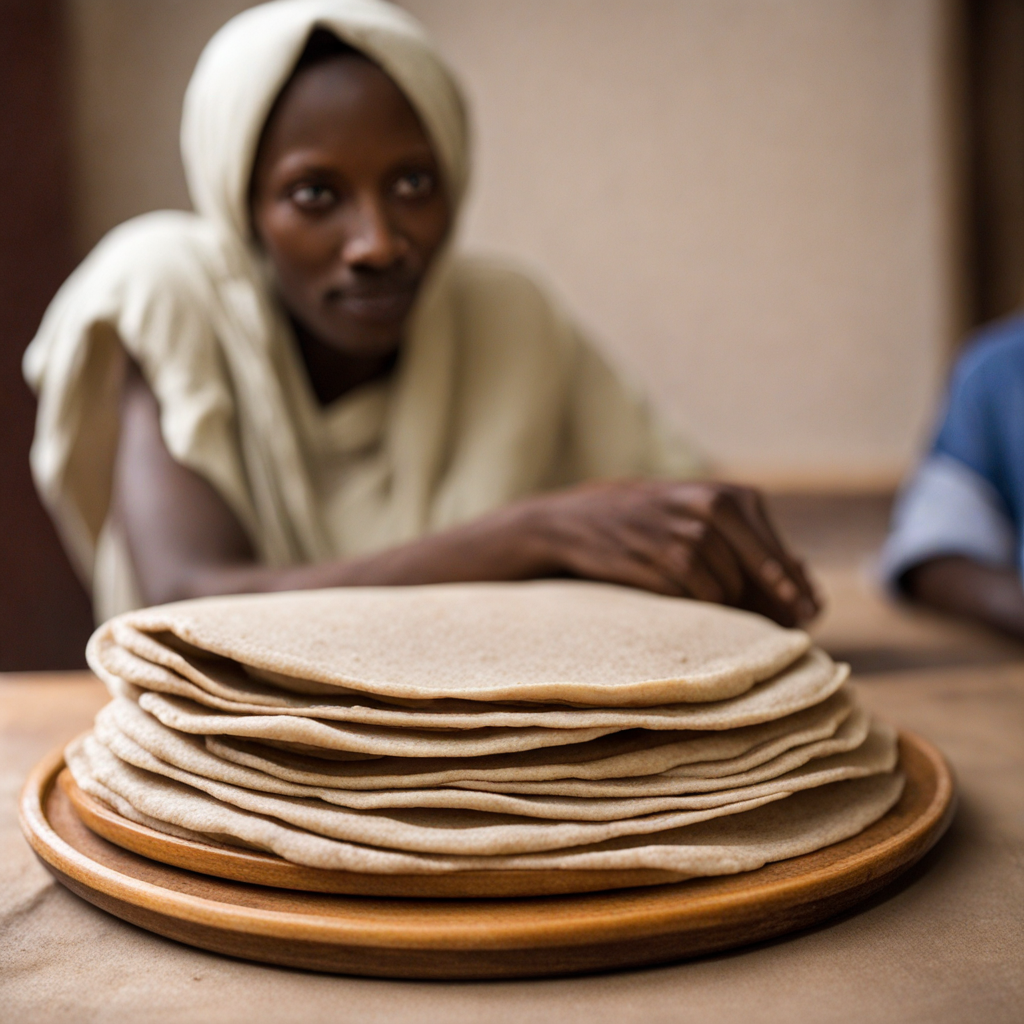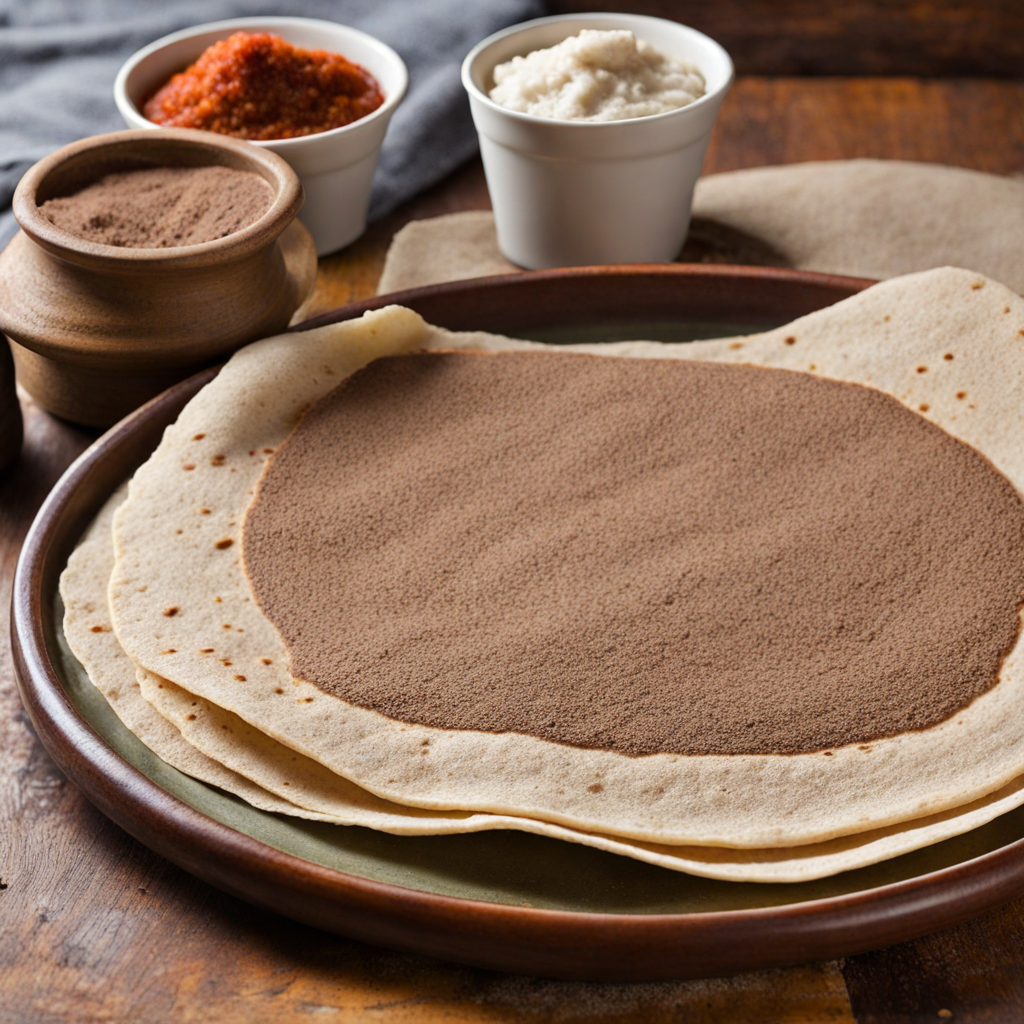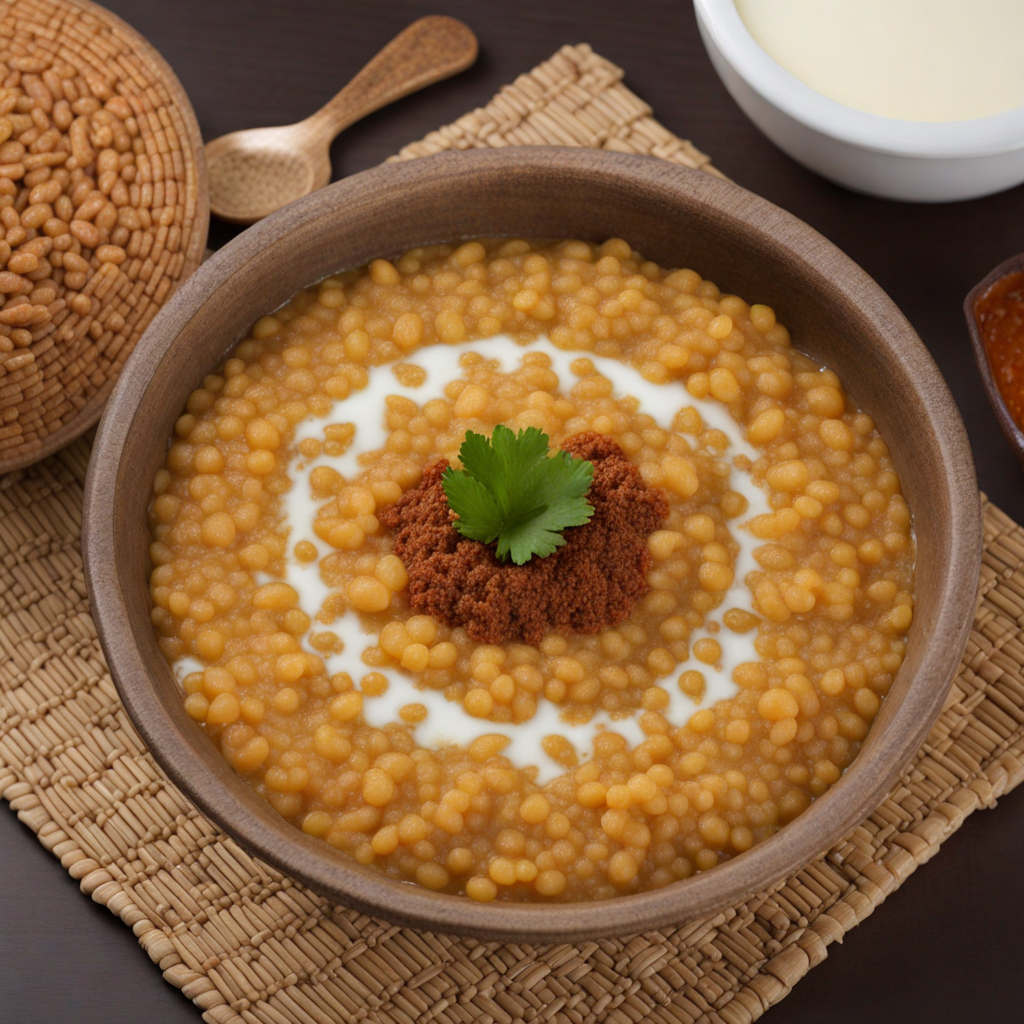Injera
Injera is a unique and flavorful Ethiopian staple that serves as both a dish and a utensil. This spongy, pancake-like flatbread is made from teff flour, which is derived from a tiny grain native to Ethiopia. The fermentation process involved in making injera gives it a distinctive sour taste and a delightful texture, featuring numerous tiny holes or "eyes" that create a porous surface. This texture not only enhances the experience of savoring Ethiopian cuisine but also allows it to soak up the rich flavors of accompanying dishes. Traditionally, injera is served on a large communal platter, topped with a variety of colorful stews and salads known as "wot." These dishes can range from spicy lentil stews to savory meat preparations, all bursting with aromatic spices like berbere and mitmita. The interplay of flavors between the tangy injera and the robust wot creates a harmonious balance that is both satisfying and memorable. Eating injera is an immersive experience, often enjoyed by tearing off pieces with your hands to scoop up the various toppings. Injera's versatility extends beyond its role in main meals; it can also be paired with lighter fare, such as salads or grilled vegetables, making it a perfect accompaniment for any dining occasion. Whether enjoyed at a bustling Ethiopian restaurant or crafted at home, injera invites you to explore the rich culinary heritage of Ethiopia, offering a taste that is not only unique but also deeply rooted in the traditions and culture of the region.
How It Became This Dish
The History of እንጀራ (Injera): Ethiopia's Culinary Treasure #### Origin and Ingredients Injera, a staple food of Ethiopia, is more than just a dish; it is a cultural emblem that embodies the heart and soul of Ethiopian society. This spongy, sour flatbread is traditionally made from teff, a tiny, nutrient-rich grain indigenous to the Ethiopian highlands. Teff is gluten-free and rich in protein, fiber, and essential minerals, making injera not only a vital source of sustenance but also a healthy dietary choice. The origins of injera can be traced back thousands of years, with evidence suggesting that its use predates the establishment of the Aksumite Empire (circa 100 AD to 940 AD). Archaeological findings indicate that the cultivation of teff began around 4000 B.C., making it one of the oldest cultivated grains in Africa. The fermentation process that gives injera its distinctive sour taste was likely developed over generations, arising from the natural yeast and bacteria present in the environment. #### Cultural Significance Injera holds a central place in Ethiopian culture, serving not only as a food item but also as a means of communal dining. Traditionally, meals are served on a large communal platter, with injera spread out as a base. Various stews, known as wot, are placed on top, creating a vibrant and colorful array of flavors and textures. This method of serving food emphasizes togetherness—eating from a shared platter fosters bonding among family and friends. Moreover, injera is often used as an eating utensil. Diners tear off pieces of injera to scoop up the stews, a practice that reinforces the communal aspect of the meal. The act of sharing food symbolizes unity and hospitality, principles deeply embedded in Ethiopian culture. It is common for guests to be offered injera as a sign of respect and welcome, further highlighting its significance beyond mere sustenance. #### Development Over Time As Ethiopia's history unfolded, so too did the preparation and significance of injera. The introduction of different cooking methods and variations in regional ingredients have led to a rich tapestry of injera styles. While teff remains the primary grain used, other grains such as barley and wheat have been incorporated into the recipe, especially in regions where teff is less accessible. The fermentation process also varies, with some regions emphasizing longer fermentation times to enhance the sourness of the injera. This variation in preparation reflects the diverse climatic conditions and cultural practices across Ethiopia's many ethnic groups. For instance, in the southern regions, injera may be thinner and more delicate, while in the north, it can be thicker and heartier. The role of injera has also evolved in response to historical events. During the Italian occupation of Ethiopia from 1936 to 1941, the food culture experienced significant disruption. Many traditional cooking methods were altered, and imported ingredients became more common. Despite these challenges, injera remained a symbol of resilience. After the occupation, there was a resurgence of interest in traditional Ethiopian cuisine, including injera, as a way of reclaiming cultural identity. #### Modernization and Globalization In recent decades, injera has gained recognition beyond Ethiopia's borders. The Ethiopian diaspora has played a crucial role in introducing injera and Ethiopian cuisine to a global audience. Restaurants specializing in Ethiopian food have proliferated in cities around the world, allowing people from diverse backgrounds to experience the flavors of injera and its accompanying dishes. As globalization continues to influence food culture, injera has adapted while maintaining its traditional roots. Innovations in preparation and presentation have emerged, such as gluten-free versions made from alternative flours, appealing to contemporary dietary preferences. However, the core essence of injera—its connection to community, history, and identity—remains unchanged. #### Symbol of Identity and Unity Injera serves as a powerful symbol of Ethiopian identity and unity. It is often featured in cultural celebrations, religious ceremonies, and festive gatherings, reinforcing its role as a bridge between past and present. During the Ethiopian New Year (Enkutatash) and other significant holidays, injera takes center stage, accompanied by a variety of traditional dishes that reflect the richness of Ethiopian culinary heritage. Furthermore, injera has become a canvas for expressing culinary creativity. Chefs in Ethiopia and around the world experiment with different flavors and ingredients, creating fusion dishes that honor traditional recipes while appealing to modern palates. This evolution showcases the adaptability of injera, allowing it to resonate with new generations while remaining rooted in its historical significance. #### Conclusion Injera is not merely a food item; it is a living testament to Ethiopia's rich history, cultural diversity, and communal values. Its origins in ancient agricultural practices, its role in fostering social connections, and its adaptability in a changing world all contribute to its status as a cherished culinary treasure. As Ethiopia continues to navigate the complexities of modern life, injera remains a steadfast symbol of resilience, unity, and identity, inviting all to partake in its delicious story. Whether enjoyed in a bustling Ethiopian restaurant or at a family gathering, injera represents the enduring spirit of a nation and its people, transcending borders and time to connect individuals through the universal language of food.
You may like
Discover local flavors from Ethiopia







